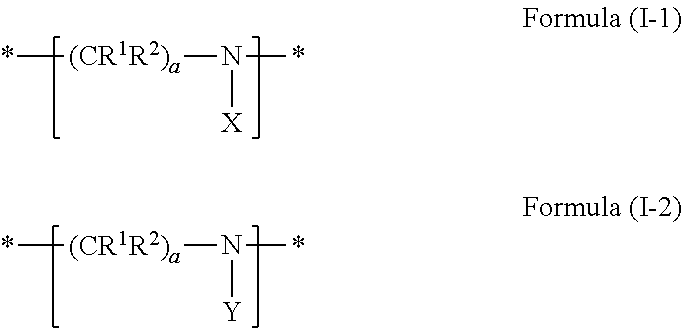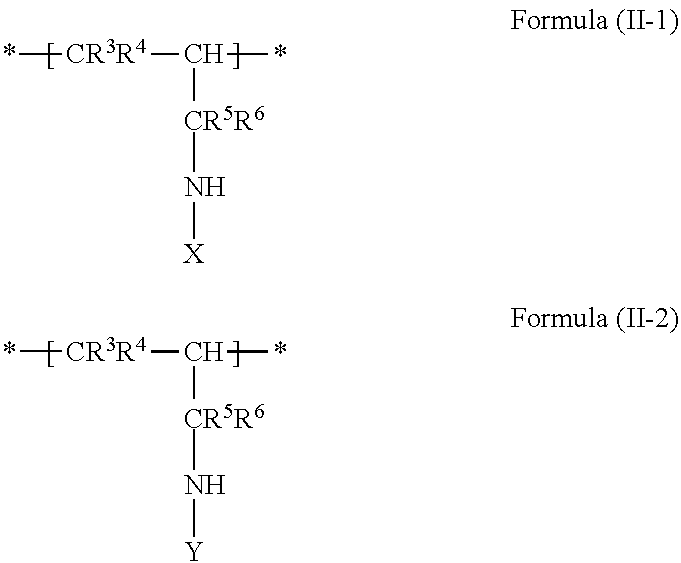Radiation-sensitive composition, method for forming pattern, color filter and method of producing the same, and solid-state image sensor
- Summary
- Abstract
- Description
- Claims
- Application Information
AI Technical Summary
Benefits of technology
Problems solved by technology
Method used
Image
Examples
example 1
(1) Preparation of Titanium Dioxide Dispersion 1-1
[0402]A mixture having the following composition A was subjected to a dispersion treatment with a circulation-type dispersing machine (bead mill), ULTRA APEX MILL (trade name, manufactured by Kotobuki Industries Co., Ltd.).
Titanium dioxide (TTO-51 (C), trade name,12.5 partsmanufactured by Ishihara Sangyo Kaisha, Ltd.)Specific dispersing resin (A) (20% solution of propylene 86. partsglycol monomethyl ether acetate (PGMEA), following structure)PGMEA350.6 parts
R = COC7H15Specific dispersing resin (A)
[0403]In Specific dispersing resin (A), k:l:m:n is 25:40:5:30 (polymerization molar ratio), p is 60, q is 60 and the weight average molecular weight is 10,000.
[0404]The dispersing machine was operated under the following conditions.
[0405]Bead diameter: 0.05 mm
[0406]Bead filling rate: 75% by volume
[0407]Circumferential velocity: 8 m / sec
[0408]Pump supply rate: 10 kg / hour
[0409]Cooling water: tap water
[0410]Volume of circular path of bead mill: ...
example 25
[0416]Titanium dioxide dispersion 2 was prepared in a manner substantially similar to Example 1, except that the mixture of composition A, prepared in the preparation of titanium dioxide dispersion 1-1 for Example 1, was changed to a mixture of the following composition B.
Titanium dioxide (TTO-51 (C), trade name, manufactured212.5 partsby Ishihara Sangyo Kaisha, Ltd.)Specific dispersing resin (A) (20% PGMEA solution)286.9 partsPGMEA350.6 partsCyclohexanone248.7 parts
[0417]Radiation-sensitive composition 25 was prepared in a manner substantially similar to Example 1, except that titanium dioxide dispersion 1-1, which was used in the preparation of radiation-sensitive composition 1 of Example 1, was changed to titanium dioxide dispersion 2 obtained above, and that PGMEA was changed to cyclohexanone.
[0418]The content of cyclohexanone in the organic solvent included in the radiation-sensitive composition of Example 25 was approximately 70%.
example 26
[0419]Radiation-sensitive composition 26 was prepared in a manner substantially similar to Example 1, except that titanium dioxide dispersion 1-1, which was used in the preparation of radiation-sensitive composition 1 of Example 1, was changed to titanium dioxide dispersion 2 prepared in Example 25, and that PGMEA was changed to a mixture of PGMEA / cyclohexanone (75% / 25%).
[0420]The content of cyclohexanone in the organic solvent included in the radiation-sensitive composition of Example 26 was approximately 20%.
[0421]Details of specific dispersion resin (B), specific dispersing resin (C), comparative dispersing resin (A), comparative dispersing resin (B), polymerizable compound (B), polymerizable compound (C) and binder polymer (B) are shown below.
[0422]DPHA, used as a polymerizable compound, refers to dipentaerythritol hexaacrylate (KAYARAD DPHA, trade name, manufactured by Nippon Kayaku Co., Ltd.)
[0423]DISPERBYK 101 (trade name), used as a dispersant in Comparative Examples 13 to 1...
PUM
| Property | Measurement | Unit |
|---|---|---|
| Sensitivity | aaaaa | aaaaa |
Abstract
Description
Claims
Application Information
 Login to View More
Login to View More - R&D
- Intellectual Property
- Life Sciences
- Materials
- Tech Scout
- Unparalleled Data Quality
- Higher Quality Content
- 60% Fewer Hallucinations
Browse by: Latest US Patents, China's latest patents, Technical Efficacy Thesaurus, Application Domain, Technology Topic, Popular Technical Reports.
© 2025 PatSnap. All rights reserved.Legal|Privacy policy|Modern Slavery Act Transparency Statement|Sitemap|About US| Contact US: help@patsnap.com



